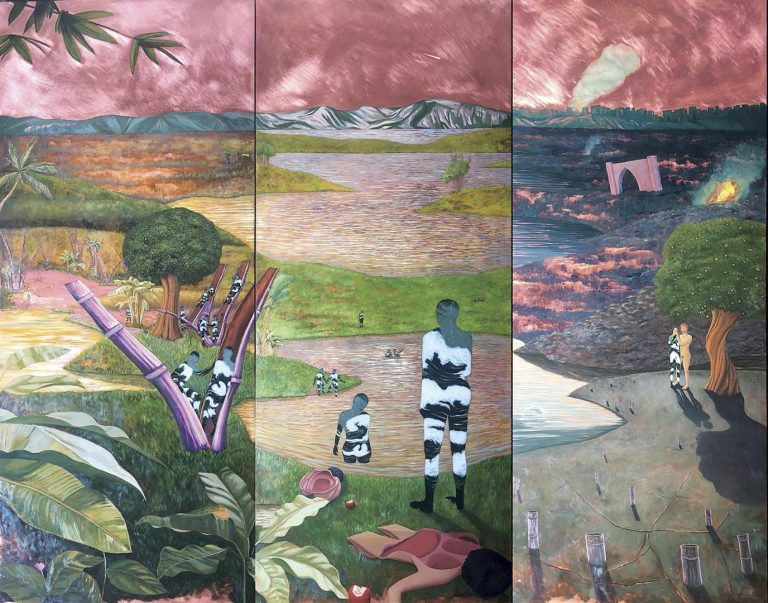We acknowledge the Traditional Owners of the land on which the Queensland Art Gallery | Gallery of Modern Art stands and recognise the creative contribution First Australians make to the art and culture of this country.

Lee Paje / The Philippines b.1980 / The Stories that Weren’t Told 2019 / Oil on copper mounted on wood / 243.84 x 300cm / Purchased 2021 with funds from Terry and Mary Peabody and Mary-Jeanne Hutchinson through the QAGOMA Foundation / Collection: QAGOMA / © Lee Paje
Lee PajeThe Stories that Weren’t Told 2019
Not Currently on Display
The Stories that Weren’t Told shows an imaginary landscape that combines elements of tropical and temperate vegetation, with fruit trees and bamboo, around a central pool or lake. The landscape is populated by a group of beings, unbound by gender, represented as human outlines filled with limitless and mysterious seascapes. These beings are able to cast off the skin that defines their gender and identity. In the foreground, a recognisably female skin lies on the ground near a half-eaten apple — the Christian symbol of original sin that saw Adam and Eve expelled from Paradise. In Paje’s painting, Eve’s sin has already taken place, yet humans still occupy this new paradise.
On the left, pairs of figures appear to materialise from stalks of bamboo as described in the Filipino myth Malakas at Maganda (loosely translated as ‘The Strong and the Beautiful’) in which the first humans — a man and a woman — emerged from the two halves of a split stalk of bamboo. Paje’s humans appear as fluid, ungendered beings.
Throughout her practice, Paje has painted on copper — a medium that was frequently used by artists during the Renaissance prior to the introduction of canvas and which remains associated with grand narratives. Paje was attracted to copper for its link to Bible stories that reinforce gender stereotypes, as well as for its durability. The copper allows her to assert the endurance of her work and her resolution that it continues to challenge prevalent social, historical and cultural stereotypes.
Across her versatile practice, Lee Paje has worked with different media to create paintings, installations and sculptures in materials such as wood, copper, paper and cast concrete. Whatever her chosen medium, her works reveal a meticulous attention to detail and refinement of technique.
Through her work, Paje is interested in disrupting narratives and metaphors that perpetuate ideologies of inequality and gender specificity, reimagining and repositioning women and gender in the past, present and future.